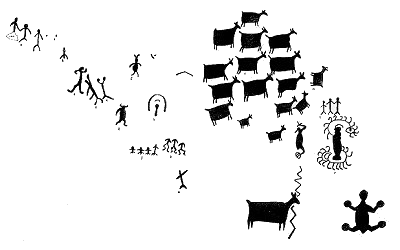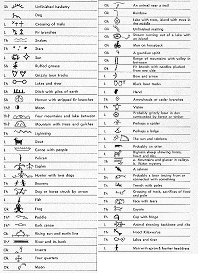 |
|||
|
|||
|
Copyright
The Mystery of B.C.'s Rock Art Paintings
Early records indicate that Okanagan Lake's famous "Ogopogo" was around even in early days. A pictograph on the east side of Okanagan Lake close to Squally Point depicts some strange creature known then by the local Indians as the "lake demon" or "Na-ha-ha-itkh" or water god. Another record describes a tremendously large painting of the lake demon on the sheer side of a mountain peak. This is supposed to be the inland lair of the demon. No white man has ever seen it, although it is supposed to be located 15 to 20 miles back in the hills from Kelowna.
Critical observation has shown that many of the sites are located at excellent campsites, which provided protection from the elements, good observation, and were often right on, or adjacent to, well-traveled Indian trails and water routes. Almost all pictographs along the shores of interior lakes are situated above the high water marks. This fact is strikingly evident on Kootenay Lake where all of the panels, with the exception of three sites, are 20 to 25 feet above low water and are easily seen from the lake. Before the dykes were built around the Creston flats, this area was subjected to annual flooding during high water. The panels here are located 10 to 15 feet above ground level where high water was not so great as in the main lake. It is believed that the painters realized that paintings were vulnerable to the wear and erosion of high water. The location of pictograph panels above the high water mark may well have coincided with annual migrations up and down the lakes between fishing and hunting areas or summer camps during the period of high water. Kootenay Lake pictographs are distributed along both the cast and west shores of the main lake. On the cast side of the lake, they extend for several miles north of Kaslo. It could have been that some Indians travelling up the west side of the lake turned west at Procter and followed the West Arm of Kootenay Lake and down the Kootenay River to its confluence with the Columbia near what is now Castlegar. Those continuing north past the West Arm might have traveled through the Lardeau country, Trout Lake and Beaton Creek into the Arrow Lakes valley.
The Chilcotin area and the interior plateau have yielded few pictograph sites. Some sites are on Stuart Lake, Fraser Lake, Babine Lake, and northeast to the Stikine area. There are no locations of paintings in the Peace River area of British Columbia, nor in the Pine Pass region. Most of the paintings appear to be located within the boundaries of the Interior Salish, Kootenay, and the Athapaskan tribes, and within the Nicola region once occupied by the Nicola Indians, now an extinct tribe of the Athapaskans. When searching for paintings on many likely looking rock surfaces, a great deal of time maybe wasted. The presence of Caloplaca sp., a colorful lichen occurring generally in the interior of the province, are easily mistaken at first glance for pictographs due to the variety of radial growth patterns and varying shades of red, orange, yellow or yellow-brown. The variation in colors of this lichen is influenced by the location; whether it is sunny, shady, very dry or moist, these factors affect the amount of paritien crystals present and thereby influence the color of the lichen. Since this lichen often grows on or close to pictographs, a casual search is not enough to confirm their presence or absence. The Indian was able to make designs which represented mountains, valleys, lakes and trails, thus there is reason to believe that they were able to sketch routes and other geographic features. Broadly speaking, most of the sites are located on granitic rock ranging from a very hard granite in the Kootenay, to a softer granite in the Okanagan, Similkameen, and Thompson Valley regions. Pictographs are found on rock outcrops, slump blocks, and single boulders both river and glacier. Besides intrusive rock, volcanic, sedimentary, and metamorphic rock also carry pictograph panels. The largest concentrations of pictographs on single boulders or rocks are in the Similkameen, South Okanagan, Lillooet, and Pavilion areas. In the Spences Bridge area, definite preference has been given to painting pictographs on large single, water or glacial smoothed hard granite boulders of a light color. The artistic and careful use of dyes by the Indians of British Columbia is well appreciated. Certain berries, fungi, and many plant roots were in common use as sources of color. Excellent dyes were obtained from lichens and by boiling the bark of alder. However, it is not likely that organic dyes were used in preparation of the paint for painting pictographs. Mineral pigments were readily available and much better suited for painting on rock surfaces. The paint used by the interior rock painters resembles that used for pictographs and petroglyphs in all parts of the world. The colors were red, black, yellow, white, and green. Red is the most common. It was symbolic of life, good luck, and virtue. Black is the color next most often used, but much less common than red. Many black pictographs are smaller, more delicately executed, and appear to be older than the red designs at sites where both colors are present. One Indian states, that, "human figures painted in black symbolize death by violence or tragedy". Evidently, two main mineral pigments were commonly used in mixing the paints. Pure hematite is a deep red and pure limonite is normally deep yellow. Under some circumstances, limonite can be black. Various shades of yellow, brown and red result when limonite and hematite are mixed with each other and with clay. The resulting materials are called "ochres", if they contain a high percentage of the iron oxides and clay. Charcoal, black carbon or soot black earth and an unidentified black exudate from rock crevices could also have been the pigment used. White paint was made from burned bone, white clay or gypsum. Deposits of red ochre or red clay are readily available, for instance at the red cliffs of Tulameen. The native name for these cliffs is 'Tsulameen' which means 'red paint.' The original name for the city of Princeton, at the fork of the Tulameen and Similkameen Rivers was "Vermilion Forks". This red ochre was an important trade item amongst the Indians of the interior. A deposit of yellow ochre occurs at a locality with the Indian name of "Skwokelow", on the east side of Adams Lake, about five miles from the south end. A sample of this yellow ochre was identified by the Department of Mines at Victoria as being potassic ferruginous clay. This deposit was examined by Dr. G. M. Dawson in the 1880's when he noted a large excavation near the beach made by the Indians in extracting the yellow ochre. Mineral pigments were also obtained at Seton Lake, downstream from Fountain, close to the junction of the Pavilion and upper Hat Creek roads, Hxon Creek, Paint Lake in Monashee Park, Lardeau River four to five miles north of the town of Lardeau and Vermilion Springs in the Kootenays. On my last trip to Princeton, I discovered yet another ochre site situated approximately 3 miles east of Princeton on the old abandoned railway bed. There you can find all the colors used by the Indians, with the exception of green. (A word of advice, don't get it on your clothing!) The red pigment was sometimes made by backing yellow ochre. The ochre was mixed with water and formed into shapes the size of a small egg. These were then flattened into discs and baked in a hot fire. This baking converted the yellow ochre into red ochre. These cakes were then pounded into a fine powder, and the resultant pigment mixed with other ingredients resulted in a paint of high quality. During the baking of yellow ochre, the combined water is driven off and the residue crystallizes as hematite. Fragments of red ore found near Spences Bridge were classified and identified by C. E. Cairns, Geological Survey of Canada, as containing impure ferric oxide. This material made a mark having the same shade as the pictographs. This suggests that the pigment may have been applied as a dry chalk, and then soaked into the rock due to moisture. Sometimes it was mixed with grease for use on the face and body. On occasion, it was made into sticks similar to our grease paints. In this form it could be easily used and carried in small pouches of buckskin. No report or evidence indicates the use of brushes in painting pictographs. Undoubtedly most of them were painted with bare fingers or with fingers covered with a soft piece of animal hide. These could have been drawn with sharpened sticks. Small hollow bones with sharpened ends may also have been used, with the paint placed in the tube or groove as in a crude pen. Most of the images can be categorized into groupings: anthropomorphic, zoomorphic, animals, humans, birds, amphibians, insects, celestial, direction and geometrics. The complete story of these paintings might never be known, but we may assume that not every member of the tribe was capable of painting even the crudest pictures. Who then were the painters? Did they paint only to give visual expression to their feelings? How did they mix paint that has lasted for so long in spite of constant exposure to the elements? "Was this the start of modern man's attempt to create art as we know and see it today?"
This article may not be copied, distributed or reprinted in any form without the author's permission. To contact the author, please use the e-mail address provided. If you are unable to contact the author, please contact the Canadian Rockhound. Authorized reprints must acknowledge the author and the Canadian Rockhound, and include the website URL address of the Canadian Rockhound.
|
||||

Copyright © 2000 Canadian Rockhound
Magazine Issues |
News & Events |
Junior Rockhound |
Resources
|
||||


